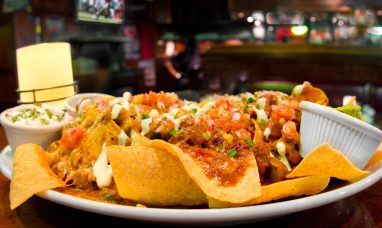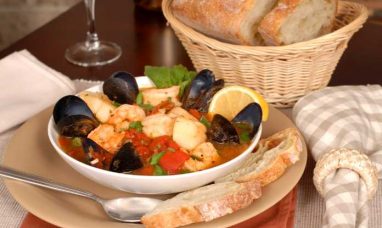NEW YORK, Jan. 8, 2025 /PRNewswire/ — Report with market evolution powered by AI – The global crab market size is estimated to grow by USD 6.07 billion from 2025-2029, according to Technavio. The market is estimated to grow at a CAGR of over 5.8% during the forecast period. Rising awareness about nutritional benefits of crabs is driving market growth, with a trend towards increasing prominence of clean labeling of crabs. However, overfishing and decline in certain species of crabs poses a challenge. Key market players include Admiralty Island Fisheries Inc., Bumble Bee Foods LLC, Cooke Aquaculture Inc., Seafood Chile SA, KEYPORT LLC, Maine Lobster Now LLC, Mazzetta Co. LLC, P and D Seafood Co., Pacific Cove, Pacific Seafood Group, SEA DELIGHT LLC, Seaview Crab Co., Sogelco International Inc., Supreme Crab and Seafood Inc., Thai Union Group PCL, The J.M. Clayton Company; Phillips Foods, Inc.; Blue Star Foods Corp.; Nippon Suisan Kaisha (Nissui); High Liner Foods Inc.; Trans-Ocean Products; Graham & Rollins, Inc.; Handy Seafood Incorporated; King Crab Legs Company; Harbor Seafood
Key insights into market evolution with AI-powered analysis. Explore trends, segmentation, and growth drivers- View Free Sample PDF
|
Crab Market Scope |
|
|
Report Coverage |
Details |
|
Base year |
2024 |
|
Historic period |
2019 – 2023 |
|
Forecast period |
2025-2029 |
|
Growth momentum & CAGR |
Accelerate at a CAGR of 5.8% |
|
Market growth 2025-2029 |
USD 6065.2 million |
|
Market structure |
Fragmented |
|
YoY growth 2022-2023 (%) |
5.4 |
|
Regional analysis |
APAC, North America, Europe, South America, and Middle East and Africa |
|
Performing market contribution |
APAC at 76% |
|
Key countries |
China, India, Indonesia, US, Vietnam, Thailand, UAE, France, Canada, Italy, Mexico; UK; Germany; Spain; Japan; Australia & New Zealand; South Korea; Brazil; South Africa |
|
Key companies profiled |
Admiralty Island Fisheries Inc., Bumble Bee Foods LLC, Cooke Aquaculture Inc., Global Seafood Chile SA, KEYPORT LLC, Maine Lobster Now LLC, Mazzetta Co. LLC, P and D Seafood Co., Pacific Cove, Pacific Seafood Group, SEA DELIGHT LLC, Seaview Crab Co., Sogelco International Inc., Supreme Crab and Seafood Inc., Thai Union Group PCL, The J.M. Clayton Company; Phillips Foods, Inc.; Blue Star Foods Corp.; Nippon Suisan Kaisha (Nissui); High Liner Foods Inc.; Trans-Ocean Products; Graham & Rollins, Inc.; Handy Seafood Incorporated; King Crab Legs Company; Harbor Seafood |
Market Driver
Crab market trends focus on nutritious seafood options, with a spotlight on the health benefits of crab. Body tissue and blood levels show high levels of good cholesterol, sterols, and antioxidants. Elements like chromium, zinc, and selenium are essential for cognitive function and a strong immune system. However, concerns over contaminants like cadmium, mercury, and arsenic persist. Sustainability is key, with readily digestible protein and lysate in demand. Automated processing equipment ensures tender meat and a delicate flavor. Convenience foods, such as pasta and soups, use crab for added nutrition. Processing technologies like high-pressure processing and canning provide efficient production and long shelf life. Crab sticks, sushi, and frozen crab meat cater to quick-service restaurants and salads. Crab cakes offer a tasty alternative to red meat. Despite these benefits, it’s crucial to address potential health risks, such as saturated fat and cancer-causing properties in some crab products. Overall, the crab market prioritizes quality, labor efficiency, and consumer convenience.
The country of origin significantly influences consumer purchasing decisions in the food industry. For instance, US consumers often prefer foods labeled as originating from the US or Canada due to perceived notions of freshness, taste, and food safety. The US implemented Country-of-Origin Labeling (COOL) to keep consumers informed and facilitate better purchasing decisions. However, the implementation of COOL incurs additional costs for producers. Consequently, the US government repealed the COOL regulations for certain regions, including Canada and Mexico, due to allegations of discrimination against their producers.
Request Sample of our comprehensive report now to stay ahead in the AI-driven market evolution!
Market Challenges
- Crab market faces several challenges in ensuring the production of safe and nutritious crab products. One major concern is maintaining the quality of crab meat during processing. The delicate tissue can be damaged during mechanical de-shelling, affecting the tender meat’s texture and flavor. Additionally, the presence of impurities like cadmium, mercury, and arsenic in crab meat is a health concern. Blood levels of sterols and cholesterol in crab can impact consumer health. Ensuring good cholesterol (HDL) levels and minimizing saturated fat is crucial. Antioxidants like selenium and omega-3 fatty acids contribute to better cognitive function and heart health. Sustainability is another challenge. Overfishing and labor concerns are prevalent in the crab industry. Automated processing equipment and efficient high-pressure processing technologies can help reduce waste and improve efficiency. Food safety is paramount. Crab products must be free from pathogens like spinal meningitis and ulcerative colitis. Processing technologies like canning and freezing can help preserve nutrients and extend shelf life. Crab meat extraction and the use of additives like lysate and chromium can impact the final product’s nutritional value and consumer perception. Balancing taste, convenience, and health considerations is a constant challenge. Competition from readily digestible alternatives like pasta, soups, and convenience foods, as well as red meat and quick-service restaurants, adds to the market’s pressure to innovate and adapt.
- The Chesapeake Bay in the United States is a significant source of various crab species, with blue crabs being the most prominent. According to the Maryland Department of Natural Resources, the blue crab population has been decreasing due to global warming, causing predators to move to cooler waters. This, in turn, has led to a decline in harvest. Strict regulations have been imposed to preserve the crab population, and several governments have temporarily banned crab fishing to prevent overfishing and depletion of stocks. This situation could negatively impact crab production and trade on a global scale, potentially increasing crab prices in international markets.
Discover how AI is revolutionizing market trends- Get your access now!
Segment Overview
This crab market report extensively covers market segmentation by
- End-user
- 1.1 Foodservice
- 1.2 Retail
- Environment
- 2.1 Aquaculture
- 2.2 Capture fisheries
- Geography
- 3.1 APAC
- 3.2 North America
- 3.3 Europe
- 3.4 South America
- 3.5 Middle East and Africa
- Type
- Application
- Distribution channel
1.1 Foodservice- The foodservice industry is the largest consumer of crabs globally, with a steady growth rate forecasted during the upcoming period. Crabmeat is a popular seafood option in many restaurants, and China’s demand for crabs is particularly high. Red Lobster, a leading restaurant chain, offers various crab and lobster dishes. Crab dishes are increasingly popular in fast-casual and quick-service restaurants worldwide. The expansion of these chains, such as Lukes Lobster and Captain D’s in the US, will significantly drive the foodservice segment’s growth during the forecast period.
Download a Sample of our comprehensive report today to discover how AI-driven innovations are reshaping competitive dynamics
Research Analysis
Crab market insights reveal a growing trend towards the consumption of omega-3 rich seafood, making crabs a popular choice for health-conscious consumers. The crab market report indicates a shift in retail trends, with an increasing preference for sustainable seafood practices and convenience. Seafood market research shows that crab market size is expected to grow significantly due to its nutritional benefits and versatility in various cuisines. Seafood preservation methods are essential in ensuring the freshness and quality of crab meat. Food technology and automated food processing solutions are being adopted to improve crab meat processing and increase production efficiency. Crab meat suppliers are exploring new distribution channels, including online sales and partnerships with restaurants and meal prep services. Seafood tourism is also driving the crab market growth, with many tourists visiting coastal areas to experience the local seafood culture. Nutritious meals and easy recipes using crab meat are gaining popularity, making it a convenient and healthy option for busy consumers. The crab market analysis indicates that competition is fierce, with numerous players vying for market share. However, opportunities exist for those who prioritize sustainable practices and innovation in crab meat processing and distribution.
Market Research Overview
Crab market offers a rich source of essential nutrients, including omega-3 fatty acids, protein, and various minerals. Crab meat is known for its tender texture and delicate flavor, making it a popular choice for various dishes, from seafood pastas and soups to salads and sushi. The nutritional benefits of crab extend beyond taste, as it contains antioxidants, selenium, zinc, and other elements that support cognitive function, immune system, and circulatory health. However, it’s essential to ensure the sustainability of crab populations and minimize the presence of heavy metals, such as cadmium, mercury, and arsenic, which can have cancer-causing properties and adversely affect the nervous system. Automated processing equipment, such as mechanical de-shelling machines, and advanced technologies, like high-pressure processing, enable the production of readily digestible crab meat, reducing the need for labor-intensive manual processing. Despite the convenience of canned and frozen crab meat, fresh crab remains a nutritious and delicious option for those seeking a quick meal or a gourmet dining experience. However, it’s important to note that crab meat contains saturated fat and cholesterol, so it should be consumed in moderation as part of a balanced diet. Additionally, some individuals with conditions like ulcerative colitis or spinal meningitis may need to avoid crab due to potential allergic reactions or interactions with their medications.
Table of Contents:
1 Executive Summary
2 Market Landscape
3 Market Sizing
4 Historic Market Size
5 Five Forces Analysis
6 Market Segmentation
- End-user
- Foodservice
- Retail
- Environment
- Aquaculture
- Capture Fisheries
- Geography
- APAC
- North America
- Europe
- South America
- Middle East And Africa
7 Customer Landscape
8 Geographic Landscape
9 Drivers, Challenges, and Trends
10 Company Landscape
11 Company Analysis
12 Appendix
About Technavio
Technavio is a leading global technology research and advisory company. Their research and analysis focuses on emerging market trends and provides actionable insights to help businesses identify market opportunities and develop effective strategies to optimize their market positions.
With over 500 specialized analysts, Technavio’s report library consists of more than 17,000 reports and counting, covering 800 technologies, spanning across 50 countries. Their client base consists of enterprises of all sizes, including more than 100 Fortune 500 companies. This growing client base relies on Technavio’s comprehensive coverage, extensive research, and actionable market insights to identify opportunities in existing and potential markets and assess their competitive positions within changing market scenarios.
Contacts
Technavio Research
Jesse Maida
Media & Marketing Executive
US: +1 844 364 1100
UK: +44 203 893 3200
Email: [email protected]
Website: www.technavio.com/
![]() View original content to download multimedia:https://www.prnewswire.com/news-releases/crab-market-to-grow-by-usd-6-07-billion-2025-2029-driven-by-rising-awareness-of-crabs-nutritional-benefits-and-ai-redefining-market-landscape—technavio-302344667.html
View original content to download multimedia:https://www.prnewswire.com/news-releases/crab-market-to-grow-by-usd-6-07-billion-2025-2029-driven-by-rising-awareness-of-crabs-nutritional-benefits-and-ai-redefining-market-landscape—technavio-302344667.html
SOURCE Technavio

Featured Image: I stock @ CabecaDemarmore

















